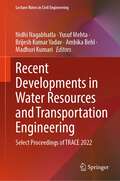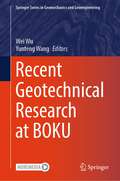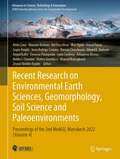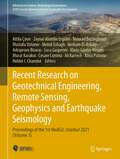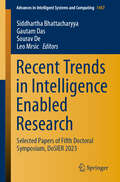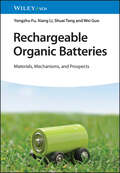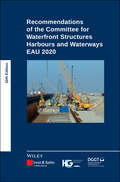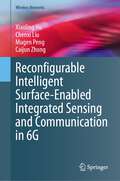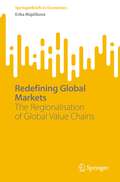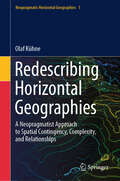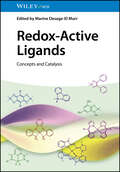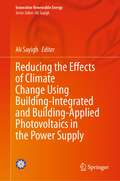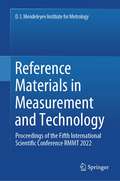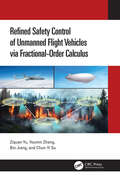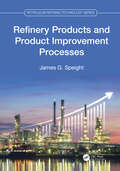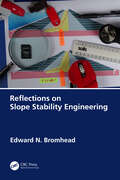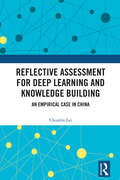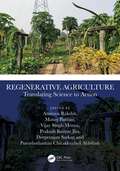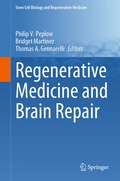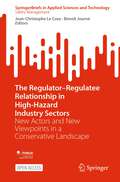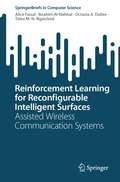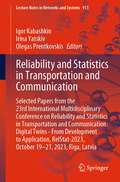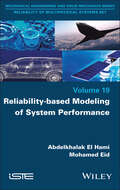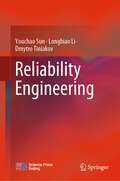- Table View
- List View
Recent Developments in Water Resources and Transportation Engineering: Select Proceedings of TRACE 2022 (Lecture Notes in Civil Engineering #353)
by Nidhi Nagabhatla Yusuf Mehta Brijesh Kumar Yadav Ambika Behl Madhuri KumariThis book comprises select proceedings of the International Conference on Trends and Recent Advances in Civil Engineering (TRACE 2022). The book focuses on the latest research works carried out in the area of water resources and transportation engineering. Various topics covered in this book include technological intervention and solution for smart and sustainability in water resources and transportation infrastructure, crop protection, resilience to disaster like flood, hurricane, and drought, traffic congestion, transport planning, green and intelligent transportation infrastructure, etc. The book is useful to researchers and practitioners working in the areas of civil engineering, water resources, and transportation engineering.
Recent Geotechnical Research at BOKU (Springer Series in Geomechanics and Geoengineering)
by Wei Wu Yunteng WangThis book offers a glimpse of the geotechnical research activities at BOKU, Vienna, in 2023. The research topics are wide-ranged including laboratory testing, constitutive modelling, numerical simulations with DEM and SPH, landslide, tunnelling and machine learning. Many research activities are carried out by visiting scholars from China.
Recent Research on Environmental Earth Sciences, Geomorphology, Soil Science and Paleoenvironments: Proceedings of the 2nd MedGU, Marrakesh 2022 (Volume 4) (Advances in Science, Technology & Innovation)
by Attila Çiner Maurizio Barbieri Md Firoz Khan Ilker Ugulu Veysel Turan Jasper Knight Jesús Rodrigo-Comino Haroun Chenchouni Ahmed E. Radwan Amjad Kallel Dionysia Panagoulia Carla Candeias Arkoprovo Biswas Helder I. Chaminé Matteo Gentilucci Mourad Bezzeghoud Zeynal Abiddin ErgülerThis book is based on the accepted papers for presentation at the 2nd MedGU Annual Meeting, Marrakesh 2022. The book presents a series of newest research studies that are nowadays relevant to Middle East, Mediterranean region, Africa, and surrounding areas. The book gives a general overview on current research, focusing on geoenvironmental issues and challenges in environmental management in these regions. It offers a broad range of recent studies that discuss the latest advances in geography, geomorphology, landslides, and soil science, in addition to geoarchaeology and geoheritage. It also shares insights on some glaciology studies. The book also enhances the understanding of paleoclimate and paleoenvironmental changes based on research studies from the fields of marine geosciences, historical geology, and paleoceanography and paleoclimatology.
Recent Research on Geotechnical Engineering, Remote Sensing, Geophysics and Earthquake Seismology: Proceedings of the 1st MedGU, Istanbul 2021 (Volume 3) (Advances in Science, Technology & Innovation)
by Attila Çiner Zeynal Abiddin Ergüler Mourad Bezzeghoud Mustafa Ustuner Mehdi Eshagh Hesham El-Askary Arkoprovo Biswas Luca Gasperini Klaus-Günter Hinzen Murat Karakus Cesare Comina Ali Karrech Alina Polonia Helder I. ChaminéThis edited book is based on the accepted papers for presentation at the 1st MedGU Annual Meeting, Istanbul, 2021. With five parts spanning a large spectrum of geological, geotechnical, and geophysical topics, this book presents a series of newest research studies that are nowadays relevant to Middle East, Mediterranean region, and Africa.The book includes the latest research studies on seismic hazard and risk assessment, earthquake geodesy, seismotectonics, archaeoseismology and active faulting, well logging methods, geodesy and exploration/theoretical geophysics, geological engineering, geotechnical engineering and geoenvironment, geo-informatics, remote sensing and geohazards, basement architecture and potential data, and numerical and analytical methods in mining sciences and geomechanics.
Recent Trends in Intelligence Enabled Research: Selected Papers of Fifth Doctoral Symposium, DoSIER 2023 (Advances in Intelligent Systems and Computing #1457)
by Siddhartha Bhattacharyya Gautam Das Sourav De Leo MrsicThis book gathers extended versions of papers presented at DoSIER 2023 (Fifth Doctoral Symposium on Intelligence Enabled Research, held at Cooch Behar Government Engineering College, West Bengal, India, during December 20–21, 2023). The papers address the rapidly expanding research area of computational intelligence, which, no longer limited to specific computational fields, has since made inroads in signal processing, smart manufacturing, predictive control, robot navigation, smart cities, and sensor design, to name but a few. Presenting chapters written by experts active in these areas, the book offers a valuable reference guide for researchers and industrial practitioners alike and inspires future studies.
Rechargeable Organic Batteries: Materials, Mechanisms, and Prospects
by Yongzhu Fu Xiang Li Shuai Tang Wei GuoA must-have reference on sustainable organic energy storage systems Organic electrode materials have the potential to overcome the intrinsic limitations of transition metal oxides as cathodes in rechargeable batteries. As promising alternatives to metal-based batteries, organic batteries are renewable, low-cost, and would enable a greener rechargeable world. Rechargeable Organic Batteries is an up-to-date reference and guide to the next generation of sustainable organic electrodes. Focused exclusively on organic electrode materials for rechargeable batteries, this unique volume provides comprehensive coverage of the structures, advantages, properties, reaction mechanisms, and performance of various types of organic cathodes. In-depth chapters examine carbonyl-, organosulfur-, radical-, and organometallic complexes, as well as polymer-based active materials for electrochemical energy storage (EES) technologies. Throughout the book, possible application cases and potential challenges are discussed in detail. Presents advanced characterization methods for verifying redox mechanisms of organic materials Examines recent advances in carbonyl-based small-molecule cathode materials in battery systems including lithium-ion, sodium-ion, and aqueous zinc-ion batteries Introduces organosulfide-inorganic composite cathodes with high electrical conductivity and fast reaction kinetics Outlines research progress on radical electrode materials, polymer-based organic cathode materials, and the development of all-organic batteries Summarizes the synthesis processes, redox mechanisms, and electrochemical performance of different kinds of organic anode materials for metal-ion batteries Featuring a general introduction to organic batteries, including a discussion of their necessity and advantages, Rechargeable Organic Batteries is essential reading for electrochemists, materials scientists, organic chemists, physical chemists, and solid-state chemists working in the field.
Recommendations of the Committee for Waterfront Structures Harbours and Waterways: EAU 2020
by HTG Deutsche Gesellschaft für GeotechnikThe recommendations have been completely restructured in this 12th (2020) edition of the EAU (10th English edition), the aim being to provide readers with a better, clearer arrangement of the chapters. In addition, the information published in the annual technical reports of the Waterfront Structures Committee since the publication of the 11th German edition have been incorporated in this new edition. The recommendations also take into account the new generation of standards consisting of Eurocode 7, the associated National Application Documents and supplementary national publications (DIN 1054:2010). In isolated instances, partial safety factors differing from those in the codes are specified on the basis of practical experience. Safety standards for ports, harbours and marine structures are therefore upheld. The recommendations satisfy the need for international acceptance in the planning, design, tendering, award of contract, construction, site supervision, acceptance and settlement of accounts for port, harbour and waterway facilities based on uniform approaches.
Reconfigurable Intelligent Surface-Enabled Integrated Sensing and Communication in 6G (Wireless Networks)
by Xiaoling Hu Chenxi Liu Mugen Peng Caijun ZhongAs the main trend and key enabling technology for next-generation wireless networks (i.e., 6G), integrated sensing and communication (ISAC) can effectively improve spectrum efficiency, hardware efficiency, and information processing efficiency. However, it faces several deficiencies, including limited coverage due to high-frequency signals and limited communication-sensing performance due to uncontrollable wireless environments. Reconfigurable intelligent surface (RIS) provides novel dimensions to address these deficiencies by intelligently manipulating the wireless propagation environment in an energy- and hardware-efficient manner. RIS-enabled ISAC is expected to comprehensively promote the multi-dimensional performance of 6G, such as communication capacity, sensing accuracy, and coverage. Nevertheless, to fully realize its potential, one needs to figure out the impacts of RIS on joint communication and sensing performance and tackle new technical challenges in beamforming design and signal processing. The goal of this book, therefore, is to deliver a thorough understanding of RIS-enabled ISAC from three perspectives: performance analysis, beamforming design, and signal processing. Specifically, the authors provide a brief introduction to RIS-enabled ISAC, including basic concepts, motivations, potential application scenarios, and an overview of the state-of-the-art research on RIS-enabled ISAC. The theoretical performance analytical frameworks of RIS-enabled ISAC and their corresponding results are also discussed. Based on this, several critical issues are identified and elaborated on, including signal processing technologies such as angle and Delay-Doppler information acquisition, and air interface technologies such as beamforming designs. Finally, the book concludes with future trends and open issues for further research.The book would be beneficial for researchers, graduate students, and industry professionals who wish to gain a comprehensive understanding of the latest developments and challenges in RIS-enabled ISAC. By providing insights into the potential of RIS-enabled ISAC and the technical challenges that need to be addressed, the book can aid in the development of practical solutions for next-generation wireless networks and contribute to the advancement of the field of wireless communications.
Redefining Global Markets: The Regionalisation of Global Value Chains (SpringerBriefs in Economics)
by Erika MajzlíkováThis book analyses the possible regionalization of global value chains, particularly in manufacturing. Amidst calls for an industrial renaissance in Europe and a resurgence of manufacturing jobs in the United States, the dynamics of global value chains have been reshaped by global pandemics, geopolitical tensions, and increased automation. Employing a multi-regional input–output model, the book scrutinizes the decline in offshoring afer the mid-2010s. It sheds light on regionalization as a pivotal force redefining global markets, and focuses on Europe and North America, revealing the strengthening of regional ties. Discussing future challenges, the book will appeal to scholars, students, and researchers, as well as practitioners and policy-makers interested in a better understanding of (de)globalization nuances connected to the evolving role of manufacturing in global value chains.
Redescribing Horizontal Geographies: A Neopragmatist Approach to Spatial Contingency, Complexity, and Relationships (Neopragmatic Horizontal Geographies #1)
by Olaf KühneThe first book in the series provides the concept of a theoretical redefinition of 'horizontal geographies'. These denote the spatial syntheses as undertaken in various disciplines, whether as regional studies, area studies, new regional geography, and many more. The basis of the redescription is philosophical neopragmatism, which has occasionally been taken up in the spatial sciences, but has never been differentiated into a theory-driven empirical research program. This development of the research program guides the present book. Philosophical neopragmatism, especially as conceptualized by Richard Rorty, focuses in particular on contingency of society, self, and language, which also allows spatial syntheses to be understood not as 'images of reality' but as contingent proposals for redescribing spaces. As a result of the complexity of spatial processes, their horizontal geographic study requires a triangulation of theories, methods, researcher perspectives, data, and the involvement of people without expert special knowledge. To highlight the contingency of the spatial syntheses, the presentation of the results - —here especially graphic and cartographic - —resorts to the attitude of irony. Regarding the six levels of trigangulation, neopragmatism acts as a meta-theoretical orientation framework. Against the background of the complexity of spatial developments on the one hand and to operationalize Rorty's principle of private self-creation and public solidarity on the other hand, Ralf Dahrendorf's concept of life chances is drawn upon. Especially in the differentiation of this concept made in this book, it serves on the one hand for an understanding access of the (also spatial) expression of options and ligatures,, and on the other hand it offers a normative framework for the evaluation of socio-spatial developments. The reference to neopragmatic studies on spatial syntheses conducted to date and evaluated in this book shows the potential of the approach elaborated here in conceptual detail for the first time.
Redox-Active Ligands: Concepts and Catalysis
by Marine Desage-El MurrRedox-Active Ligands Authoritative resource showcasing a new family of ligands that can lead to better catalysts and promising applications in organic synthesis Redox-Active Ligands gives a comprehensive overview of the unique features of redox-active ligands, describing their structure and synthesis, the characterization of their coordination complexes, and important applications in homogeneous catalysis. The work reflects the diversity of the subject by including ongoing research spanning coordination chemistry, organometallic chemistry, bioinspired catalysis, proton and electron transfer, and the ability of such ligands to interact with early and late transition metals, lanthanides, and actinides. The book is divided into three parts, devoted to introduction and concepts, applications, and case studies. After the introduction on key concepts related to the field, and the different types of ligands and complexes in which ligand-centered redox activity is commonly observed, mechanistic and computational studies are described. The second part focuses on catalytic applications of redox-active complexes, including examples from radical transformations, coordination chemistry and organic synthesis. Finally, case studies of redox-active guanidine ligands, and of lanthanides and actinides are presented. Other specific sample topics covered include: An overview of the electronic features of redox-active ligands, covering their historical perspective and biological backgroundThe versatility and mode of action of redox-active ligands, which sets them apart from more classic and tunable ligands such as phosphines or N-heterocyclic carbenesPreparation and catalytic applications of complexes of stable N-aryl radicals Metal complexes with redox-active ligands in H+/e- transfer transformations By providing up-to-date information on important concepts and applications, Redox-Active Ligands is an essential reading for researchers working in organometallic and coordination chemistry, catalysis, organic synthesis, and (bio)inorganic chemistry, as well as newcomers to the field.
Reducing the Effects of Climate Change Using Building-Integrated and Building-Applied Photovoltaics in the Power Supply (Innovative Renewable Energy)
by Ali SayighThis book looks at the success and continuing potential of photovoltaic (PV) technology in combating climate change by harnessing solar energy through building-integrated (BIPV) and building-applied photovoltaics (BAPV). With PV global capacity soaring from 940 GW in 2021 to 1100 GW in 2022 and projected to reach 1456 GW by the end of 2023, the world is witnessing an unprecedented shift towards renewable energy solutions. Today, no single country exists without some form of PV installation, driven by reduced costs and abundant free sunshine. The book’s chapters delve into the advancements in PV technology, exploring its integration as an essential building material by examining 14 countries and regions – Brazil, The Netherlands, Austria, Poland, Argentina, Iran, Germany, Malaysia, Oman, Bahrain, India, Australia, the United Kingdom, and Egypt – and providing a comprehensive overview of their successful adoption of PV for electricity generation. Whether you’re an architect, builder, engineer, or climate advocate, this vital resource offers insights, international case studies, and a path to a greener future.
Reference Materials in Measurement and Technology: Proceedings of the Fifth International Scientific Conference RMMT 2022
by Egor P. Sobina Sergey V. Medvedevskikh Olga N. Kremleva Ivan S. Filimonov Elena V. Kulyabina Anna V. Kolobova Andrey V. Bulatov Vladimir I. DobrovolskiyThe book covers in particular state-of-the-art scientific research about product quality control and related health and environmental safety topics, including human, animal and plant safety assurance issues. These conference proceedings provide contemporary information on the general theoretical, metrological and practical issues of the production and application of reference materials.Reference materials play an integral role in physical, chemical and related type of measurements, ensuring their uniformity, comparability and the validity of quantitative analysis as well as, as a result, the objectivity of decisions concerning the elimination of technical barriers in commercial and economic, scientific and technical and other spheres of cooperation. The book is intended for researchers and practitioners in the field of chemistry, metrologists, technical physics, as well as for specialists in analytical laboratories, or working for companies and organizations involved in the production, distribution and use of reference materials.
Refined Safety Control of Unmanned Flight Vehicles via Fractional-Order Calculus
by Ziquan Yu Youmin Zhang Bin Jiang Chun-Yi SuThe monograph explores the safety of unmanned flight vehicles via the corresponding fault-tolerant control design methods. The authors analyse the safety control issues of unmanned flight vehicles, which include finite-time recovery against faults, concurrence of actuator faults and sensor faults, concurrence of actuator faults and wind effects, and faults encountered by a portion of unmanned flight vehicles in a distributed communication network. In addition, the commonly used simple but effective proportional-integral-derivative structure is also incorporated into the safety control design for unmanned flight vehicles. By using the fractional-order calculus, the developed safety control results are able to ensure flight safety and achieve the refined performance adjustments against faults and wind effects. The book will be of interest to 3rd/4th year undergraduate students, postgraduate and graduate students, researchers, academic staff, engineers of aircraft and unmanned flight vehicles.
Refinery Products and Product Improvement Processes (Petroleum Refining Technology Series)
by James G. SpeightThis book focuses on the various refinery products, product improvement processes, and solvent processes that are used in the refining industry and the processes used in product improvement to ensure products meet sales specifications. This accessible book is written for engineers, scientists, students, and academics wanting an update on crude oil processing and insight into the direction of the industry.Key features:• Describes the development of technologies for a variety of feedstocks, including heavy feedstocks utilizing advanced pre-treatment processing and hydrotreating.• Presents the initial refining processes and prepares for the new changes and evolution of the industry, including the role of biomass in the future refinery. • Analyses catalyst deactivation mechanism for developing optimum technologies for processing feedstocks with low reactivity.• Includes an extensive glossary which will be beneficial for non-technical readers.
Reflections on Slope Stability Engineering
by Edward N. BromheadSlope stability engineering is both an art and a science practised by many civil and geotechnical engineers involved in work on landslides, earth dams, breakwaters, coastal defence, earthworks slopes for roads, canals, railways, pipelines, housing developments, and other related developments. This book contains the detailed reflections of its author, who has practised and researched in the field for over a half-century. It is written in an informal style that makes it an interesting and thought-provoking practitioner guide to landslides and slope problems and their investigation, analysis, and remediation, considering both natural and man-made slopes and earthworks, and without the need for the usual equations and illustrations. Reflections on Slope Stability Engineering is targeted primarily at practitioners working in the investigations of slope instability and the design and construction of treatments of the problem, especially those early in their careers, but the accessible style also suits students who are developing an interest in the subject and even those engineers with only a casual interest in this branch of geotechnics.
Reflective Assessment for Deep Learning and Knowledge Building: An Empirical Case in China
by Chunlin LeiKnowledge building aims to transform schools into learning communities and bring knowledge creation into schools. The book therefore elaborates on how learning, technology, and assessment can be aligned both online and offline to facilitate such a process.Adopting a quasi-experimental design and drawing on rich data from forum discussions, questionnaires, interviews, learning outcomes, and classroom presentations, this book shows that the knowledge building environment, augmented by reflective assessment and principles, helped Chinese students to develop a deeper approach to learning, improved academic performance, and promoted collective knowledge advances. The book also discusses the potentials and challenges of designing technology-supported, assessment- and principle-based learning environments in tertiary contexts, especially when deep learning and knowledge building capacity are greatly emphasised in the knowledge era.The book will be of interest to scholars and educators working in learning sciences and computer-supported collaborative learning.
Regenerative Agriculture: Translating Science to Action
by Amitava Rakshit Manoj Parihar Vijay Singh Meena Prakash Kumar Jha Deepranjan Sarkar Purushothaman Chirakkuzhyil AbhilashThis book aims to focus on the current state of knowledge and scientific advances about the complex and intertwined issues of regenerative farming as a transformative solution for offsetting the disastrous climate effects of burning fossil fuels and impairments of natural resource bases. Regenerative agriculture advocates no-till practices, planting cover crops, integrating livestock and crop production, improving animal welfare practices, improving the social and economic well-being of communities, sequestering carbon, improving soil health, and increasing yields and profit with a positive impact on food access or food safety regardless of farm size.This book examines the innovations that will equip agriculture to cope with the competing challenges of addressing food and nutrition security, improving livelihoods, combatting climate change, and sustainably managing natural resources. The scope of this book extends to agricultural scientists, students, consultants, site owners, industrial stakeholders, regulators, and policymakers.
Regenerative Medicine and Brain Repair (Stem Cell Biology and Regenerative Medicine #75)
by Philip V. Peplow Bridget Martinez Thomas A. GennarelliThis book presents the latest knowledge, trends, and advances in cell transplantation and innovations in developing microspheres, 3D biomaterial constructs to enhance transfer, and cell survival to specific regions of the brain. Neurodegenerative diseases and brain injury are increasing. Medications currently only temporarily reduce some of the symptoms but do not cure or delay progression of the disease. Development of effective treatments dramatically improves the independent living and quality of life of patients. Cell transplantation strategies offer an approach to facilitating brain repair, but efficacy is often limited by low in vivo survival rates of cells that are injected in suspension. Transplanting cells that are attached to or encapsulated within a biomaterial construct has the advantage of maintaining cell-cell and cell-material interactions and improving cell survival in vivo. Biomaterials that have been used in preclinical studies to assist with in vivo cell transfer and survival include heparin-chitosan microspheres, poly(lactic-co-glycolic acid) microspheres, RADA 16 microspheres, poly(desaminotyrosyl tyrosine ethyl ester carbonate) microscale scaffolds, carbon nanotubes, collagen-chitosan scaffolds, poly(L-lactic acid) scaffolds, agarose hydrogels, gelatin methacrylate hydrogels, and agarose micro-columns with an extracellular matrix interior. Incorporating growth factors (e.g., glial-derived neurotrophic factor, neurotrophin 3) into the biomaterial constructs increased cell survival and incorporation into the host tissue. International experts in the fields of both experimental and clinical neurological research contribute chapters to this book and discuss the latest achievements in cell transplantation and matrix-assisted cell transfer/survival technologies for diseases such as Alzheimer’s disease, Parkinson’s disease, and brain injuries such as stroke and traumatic brain injury. It is envisaged that research findings in experimental animal models of Alzheimer’s disease, Parkinson’s disease, traumatic brain injury, and stroke promote clinical trials using biomaterial-assisted transfer of cells.
The Regulator–Regulatee Relationship in High-Hazard Industry Sectors: New Actors and New Viewpoints in a Conservative Landscape (SpringerBriefs in Applied Sciences and Technology)
by Jean-Christophe Le Coze Benoît JournéThis open access book addresses relationships that develop from the complex set of legislative, regulatory, and institutional arrangements that arise in the governance of high-hazard industries, especially those connected with safety. It analyses the difference in practices between high-hazard sectors such as nuclear power, chemical processing, and transport with those in the finance and healthcare sectors. The relationship between regulating and regulated entities is important in ensuring that safety is not subordinated to other concerns and in maintaining public confidence. As a result, the brief addresses various pressures and trade-offs inherent in that relationship, trade-offs between such considerations as: cost of the oversight activity and its effectiveness; regulator independence and its level of competency and understanding of the risks involved; ability to provide advice on meeting regulatory goals and being able to criticize decisions made; and effectiveness and intrusion in operational activities. The contributors show how, over time, a more horizontal or “decentred” approach to regulatory oversight has appeared, with a larger degree of delegation of certain decisions to industry and a greater role for a range of third parties such as certification bodies, auditors, insurers, industry associations and NGOs. This book is of interest to academics working in the fields of safety science or organizational management and to practitioners, regulators and policy-makers concerned with health and safety and critical infrastructure.
The Regulatory Landscape in the EU for Dairy Products Derived from Precision Fermentation: An Analysis on the Example of Cheese (SpringerBriefs in Law)
by Federica Ronchetti Laura Springer Kai P. PurnhagenThis book assesses the EU legal framework applicable to dairy products obtained through precision fermentation. It maps the authorisation and labelling requirements for these products to be placed on the EU market. It compares these provisions to those governing the food markets in the USA and Singapore, which are considered to be more innovation-friendly. At the time of writing, the precision-fermented dairy sector is still in the developmental phase, with only a few precision-fermented dairy alternatives available on the market, none of which are present in the EU. Regulatory uncertainty has been cited as significant obstacle for food business operators seeking to introduce alternative protein products in the EU. The book confirms these reports, as the current EU regulatory framework presents several legal uncertainties that are challenging for food business operators to overcome. Broadly speaking, there are two authorisation frameworks applicable to dairy products obtained through precision fermentation in the EU. The choice between these frameworks depends on the presence of genetically modified organisms (GMOs) or residues thereof in the final product. If such GMOs or residues are present, the pre-market authorisation procedure is governed by the Genetically Modified Food and Feed Regulation (GMFR). If the final product does not contain any GMOs or residues, it falls under the scope of the Novel Food Regulation (NFR), and the pre-market authorisation procedure is governed accordingly. Both of these authorisation pathways entail high regulatory requirements, which can pose challenges for the development of the precision fermentation sector. Despite the difficulty in accurately classifying products, it is crucial for food business operators to comprehend the applicable legal framework early in the product development process, given that the authorisation paths differ in their standards. In addition to pre-market authorisation requirements, companies must address labelling issues. Food labelling shall provide a basis for consumers to make informed choices in relation to the foods they consume. The primary objective of EU food labelling law is to prevent consumer deception , making it crucial for dairy products and their animal-free alternatives, to adhere to a stringent naming law as stipulated in the Common Market Organisation and specific accompanying legislation. Moreover, it is imperative to consider regulations regarding the use of health and nutrition claims, as well as labels such as “vegan” or “organic”, etc. Furthermore, the labelling of novel foods and genetically modified foods may necessitate mandatory information specified in the authorisation process. The book serves as a comprehensive guideline for food business operators involved in the production of precision-fermented dairy alternatives, aiding them in navigating the intricate European regulatory landscape.
Reinforcement Learning for Reconfigurable Intelligent Surfaces: Assisted Wireless Communication Systems (SpringerBriefs in Computer Science)
by Alice Faisal Ibrahim Al-Nahhal Octavia A. Dobre Telex M. NgatchedThis book presents the intersection of two dynamic fields: Reinforcement Learning (RL) and RIS- Assisted Wireless Communications. With an emphasis on both discrete and continuous problems, it introduces a comprehensive overview of RL techniques and their applications in the evolving world of RIS-assisted wireless communications. Chapter 1 introduces the fundamentals of RL and deep RL (DRL), providing a solid foundation for understanding subsequent chapters. It also presents the Q-learning, deep Q-learning, and deep deterministic policy gradient algorithms. Chapter 2 provides a holistic overview of RIS-assisted systems and details several use cases in wireless communications. Then, Chapters 3 and 4 present various applications of the discrete and continuous DRL to RIS-assisted wireless communications. From maximizing the sum-rate to minimizing, the system resources and maximizing the energy efficiency. These chapters showcase the versatility of the DRL algorithms in tackling arange of challenges. This book concludes with Chapter 5, which introduces the challenges and future directions in this field. It explores the particulars of hyperparameter tuning, problem design, and complexity analysis, while also highlighting the potential of hybrid DRL, multi-agent DRL, and transfer learning techniques for advancing wireless communication systems. Optimizing RIS-Assisted Wireless Systems requires powerful algorithms to cope with the dynamic propagation environment. DRL is envisioned as one of the key enabling techniques to exploit the full potential of RIS-Assisted Wireless Communication Systems. It empowers these systems to intelligently adapt to dynamic wireless environments, maximize performance metrics, and adjusts their configurations to accommodate diverse use cases efficiently. This book serves as a valuable resource, shedding light on the potential of DRL to optimize RIS-Assisted Wireless Communication, enabling researchers, engineers, advanced level students in computer science and electrical engineering and enthusiasts to grasp the intricacies of this topic. It offers a comprehensive understanding of the principles, applications, and challenges, making it a reference to recognize the full potential of the RIS technology in modern wireless communication systems.
Reliability and Statistics in Transportation and Communication: Selected Papers from the 23rd International Multidisciplinary Conference on Reliability and Statistics in Transportation and Communication: Digital Twins - From Development to Application, RelStat-2023, October 19-21, 2023, Riga, Latvia (Lecture Notes in Networks and Systems #913)
by Igor Kabashkin Irina Yatskiv Olegas PrentkovskisThis book reports on cutting-edge theories and methods for analyzing complex systems, such as transportation and communication networks and discusses multi-disciplinary approaches to dependability problems encountered when dealing with complex systems in practice. The book presents the most relevant findings discussed at the 23rd International Multidisciplinary Conference on Reliability and Statistics in Transportation and Communication (RelStat 2023), which took place as a hybrid event on October 19 – 21, 2023, in/from Riga, Latvia. It spans a broad spectrum of advanced theories and methods, giving a special emphasis to the digitalization of transport systems, as well as smart, artificial intelligence, and digital twins applications.
Reliability-based Modeling of System Performance
by Abdelkhalak El Hami Mohamed EidProbabilistic modeling of system performance, built primarily on the foundation of reliability theory, is referred to as reliability-based modeling. This book progressively builds up the functional complexity of system modeling. It starts by modeling the simplest system that can be designed, and then moves to the functional modeling of the multi-state system, step-by-step. Reliability-based Modeling of System Performance deals with modeling the functioning of systems by presenting its concepts, methods and mathematical tools. It is accessible to engineering students and academics who have already acquired basic knowledge of probability theory, applied statistics, differential calculus, integrals, combinatorial calculus and Boolean algebra.
Reliability Engineering
by Youchao Sun Longbiao Li Dmytro TiniakovThis textbook covers the fundamentals of reliability theory and its application for engineering processes, especially for aircraft units and systems. Reliability basis was explained for the best understanding of reliability analysis application for engineering systems in aviation industry. Several approaches for the reliability analysis and their application with examples are presented. It also introduces main trends in the modern reliability theory development.This book will be interested for university students and early-career engineers of aviation industry majors.
